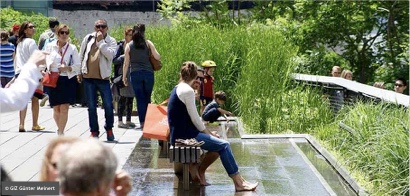Proximity City improving access, avoiding transport
by Cornie Huizenga and Mark Major

Transforming urban mobility
Urban transport systems are already under pressure with growing congestion in most urban areas. To cope with the additional 2.3 billion people expected to be living in urban areas by 2050, the rising demand for transport per person and the urgent need to reduce greenhouse gas emissions, we need a rapid transformation in urban mobility patterns and modes.
People need access, not transport – and that means access to educational, economic, social and cultural opportunities. A lack of access to urban opportunities is often a major cause of poverty and inequality. Providing disadvantaged groups with better urban access and connecting them to opportunities and services is the way to overcome urban inequality.
Increasingly, we have new digital possibilities to provide people with access to information and services without them needing to travel. However, physical access will remain the principal form of access.
Urban mobility can be transformed through the use of the ASI approach: AVOID the need to travel, SHIFT transport to more sustainable modes and IMPROVE performance (lighter, cleaner, safer, cheaper) of individual modes of transport. Much effort already goes into improving modes of transport and encouraging mode shift to more sustainable solutions – but the key role of avoiding transport is often overlooked.
Avoiding the need to travel
Urban planners and city managers have a key role to play in minimising travel demand by avoiding the need to travel, reducing trip lengths and creating the conditions to make walking, cycling and public transport attractive.
Planners need to plan mixed land use areas to ensure people live close to the things they need regular access to (shops, schools, health care, employment etc.). This avoids the need to travel and also stimulates diverse, vibrant local communities.
Shorter, local trips make walking or cycling increasingly suitable modes of transport. City managers need to design, construct and maintain high-quality links that make walking and cycling safe, easy and direct and also suitable for people with reduced mobility. Creating and linking more high-quality shared public spaces has important social and environmental benefits, besides the positive health impacts of more walking and cycling. Public spaces can recover their function as places to spend time and as links by providing spaces where people can meet and play.
Good urban planning (density, layout, allocation of road space etc.) also facilitates the provision of high-quality public transport (fast, regular, reliable, safe, safe) that can move people efficiently, safely and cheaply – and make much better use of road space at peak times. New forms of efficient, shared mobility are developing fast, but also need to be planned for e.g. reserved spaces for shared vehicles, delivery lockers, charging points, public bikes stations, priority lanes.
Delivering “Access for all”
The UN 2030 Sustainable Development Agenda was agreed in 2015 and includes 17 Sustainable Development Goals (SDGs) and Targets. SDG Target 11.2 aims to “provide access to safe, affordable, accessible and sustainable transport systems for all, improving road safety, notably by expanding public transport, with special attention to the needs of those in vulnerable situations, women, children, persons with disabilities and older persons” by 2030.
Sustainable urban mobility, through providing safer, cheaper, more accessible and cleaner disproportionately benefits vulnerable groups such as children, the elderly, the poor and people with disabilities.
There are three necessary elements to deliver widespread reductions in transport demand:
Capacity Building. To reduce transport demand through dramatically improved planning requires widespread and systematic capacity building at the local and national levels in order to equip all cities and municipalities with the necessary means to reduce transport demand as part of sustainable, low carbon cities.
Urgency. Decisions in the next years will “lock in” transport and land use patterns for decades to come. We need to take urgent action now to avoid locking ourselves into unsustainable, low density, high carbon lifestyles.
National policy and planning frameworks. Cities work within national rules and frameworks. National governments, who often agree to ambitious action in UN meetings, need to provide the appropriate national policy and planning frameworks to deliver action in all cities.
Action on urban transport demand now will deliver huge benefits at the personal, city and global level. Some of life’s simplest pleasures, such as a safe bike ride to school or bumping into friends as you walk to the shops, require good planning.
This article was originally published by URBANET at http://www.urbanet.info/proximity-city-improving-access-avoiding-transport/